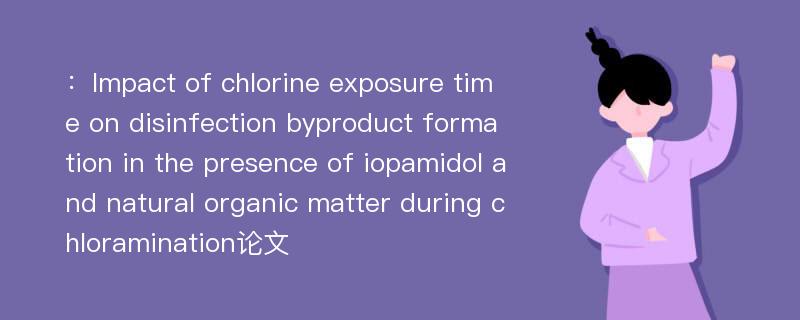
本文主要研究内容
作者(2019)在《Impact of chlorine exposure time on disinfection byproduct formation in the presence of iopamidol and natural organic matter during chloramination》一文中研究指出:Chloramines,in practice,are formed onsite by adding ammonia to chlorinated drinking water to achieve the required disinfection.While regulated disinfection byproducts(DBPs)are reduced during chloramine disinfection,other DBPs such as iodinated(iodo-)DBPs,that elicit greater toxicity are formed.The objective of this study was to investigate the impact of prechlorination time on the formation of both halogen-specific total organic halogen(TOX)and iodo/chlorinated(chloro-)DBPs during prechlorination/chloramination in source waters(SWs)containing iopamidol,an X-ray contrast medium.Barberton SW(BSW)and Cleveland SW(CSW)containing iopamidol were prechlorinated for 5–60 min and afterwards chloraminated for 72 hr with ammonium chloride.Chlorine contact time(CCT)did not significantly impact total organic iodine(TOI)concentrations after prechlorination or chloramination.Concentrations of total organic chlorine(TOCl)formed during prechlorination did not significantly change regardless of pH and prechlorination time,whileTOClappearedtodecreaseafter 72 hrchloraminationperiod.Dichloroiodomethane(CHCl2I)formation during prechlorination did not exhibit any significant trends as a function of p H or CCT,but after chloramination,significant increases were observed at pHs 6.5 and 7.5 with respect to CCT.Iodo-HAAs were not formed during prechlorination but were detected after chloramination.Significant quantities of chloroform(CHCl3)and trichloroacetic acid(TCAA)were formed during prechlorination but formation ceased upon ammonia addition.Therefore,prechlorination studies should measure TOX and DBP concentrations prior to ammonia addition to obtain data regarding the initial conditions.
Abstract
Chloramines,in practice,are formed onsite by adding ammonia to chlorinated drinking water to achieve the required disinfection.While regulated disinfection byproducts(DBPs)are reduced during chloramine disinfection,other DBPs such as iodinated(iodo-)DBPs,that elicit greater toxicity are formed.The objective of this study was to investigate the impact of prechlorination time on the formation of both halogen-specific total organic halogen(TOX)and iodo/chlorinated(chloro-)DBPs during prechlorination/chloramination in source waters(SWs)containing iopamidol,an X-ray contrast medium.Barberton SW(BSW)and Cleveland SW(CSW)containing iopamidol were prechlorinated for 5–60 min and afterwards chloraminated for 72 hr with ammonium chloride.Chlorine contact time(CCT)did not significantly impact total organic iodine(TOI)concentrations after prechlorination or chloramination.Concentrations of total organic chlorine(TOCl)formed during prechlorination did not significantly change regardless of pH and prechlorination time,whileTOClappearedtodecreaseafter 72 hrchloraminationperiod.Dichloroiodomethane(CHCl2I)formation during prechlorination did not exhibit any significant trends as a function of p H or CCT,but after chloramination,significant increases were observed at pHs 6.5 and 7.5 with respect to CCT.Iodo-HAAs were not formed during prechlorination but were detected after chloramination.Significant quantities of chloroform(CHCl3)and trichloroacetic acid(TCAA)were formed during prechlorination but formation ceased upon ammonia addition.Therefore,prechlorination studies should measure TOX and DBP concentrations prior to ammonia addition to obtain data regarding the initial conditions.
论文参考文献
论文详细介绍
论文作者分别是来自Journal of Environmental Sciences的,发表于刊物Journal of Environmental Sciences2019年04期论文,是一篇关于,Journal of Environmental Sciences2019年04期论文的文章。本文可供学术参考使用,各位学者可以免费参考阅读下载,文章观点不代表本站观点,资料来自Journal of Environmental Sciences2019年04期论文网站,若本站收录的文献无意侵犯了您的著作版权,请联系我们删除。
